Matador Network's Blog, page 1138
March 20, 2019
History of popular condiments

Condiments can make or break a meal. They’re the addition that saves a dry sandwich and the extra touch that spices up a bit of sushi. No matter what you’re eating, there always seems to be a condiment on the side that is there to at least improve a dish, if not save it entirely. It’s something that has been done throughout history — something that’s immediately clear as soon as you take a deeper look at where your favorite condiments come from.
This is how your favorite condiments came to dominate your plate.
Ketchup

Photo: neil langan/Shutterstock
Ketchup is the most ubiquitous condiment in America. It’s on your fries and burgers, mixed into your currywurst sauce, and squeezed onto your hotdogs (unless you’re in Chicago). Its appeal is easy to understand: It has a savory kick from the umami-rich tomatoes while also having a fair amount of acidity (depending on the brand) and sweetness. Like some of the best things in America, though, it’s far from an American invention.
Ketchup comes from the Chinese word kê-tsiap, which is a fermented fish sauce from Vietnam. From there, it made its way to England in the late 1600s. A recipe was published in 1732 with the title “Ketchup in Paste.” Those early ketchups tried to emulate the savory fish taste and used anchovies and mushrooms. It drifted toward the ketchup we know today with the addition of tomatoes, a New World crop. It was an Industrial Age staple and one of the first packaged foods. Heinz opened in 1869 in Pennsylvania and is largely responsible for turning ketchup into the squeezable, adaptable (Mayochup, anyone?) condiment that we know today.
Mayonnaise

Photo: Africa Studio/Shutterstock
Mayonnaise is either the best or worst condiment, depending on who you ask. Some won’t eat fries without some mayonnaise while others point to mayonnaise as the root of all that is unhealthy in America. The egg-based condiment was (probably) first created in Spain, although there’s some tension over whether a French chef actually invented it during the Seven Years’ War after winning a battle on an island that’s now part of Spain in 1756. According to legend, Duke de Richelieu’s chef whipped up the first mayonnaise using eggs and cream for a victory meal. Spanish chefs, however, also lay claim.
Regardless, as you might be able to tell from the name, mayonnaise was popularized by the French and came to America as French cuisine. It was initially an ingredient for the upper class, and rich New Yorkers mixed it into their salads. With industrialization came the rise of mayonnaise as a working man’s sandwich ingredient and the fall of luxurious handmade mayonnaise.
Mustard

Photo: Patryk Michalski/Shutterstock
Mustard is the OG condiment. Mustard seeds have been found in Egyptian tombs, and evidence of its use as a condiment goes back to Roman times. Ancient Romans ground the seeds into a paste and mixed it with wine or grape must (the skins and seeds leftover from fermentation) to spread on whatever they were eating. French monks did the same. The word mustard comes from the Latin for burning wine, mustum ardens, which is likely a reference to the spicy nature of mustard seeds. That spice is part of the reason why mustard has been used as everything from a stimulant to a pain reliever to a food enhancer.
Local mustard can be found in pretty much every country with a European influence, and most of it is a far stretch from the spicy stuff that made it popular in its early days. There’s French Dijon, English mustard, American yellow mustard, and the many (many) types of German mustard.
Wasabi

Photo: karins/Shutterstock
You’d be hard-pressed to find a sushi restaurant that serves up its rolls without a little scoop of wasabi. While it’s generally relegated to raw fish in Western cultures, it’s hard to imagine the rise of sushi restaurants without it. Wasabi dates back to Japan’s Asuka period between 538 and 710, and there’s written evidence that it was used alongside other medicinal plants. Its popularity is tightly linked to medicinal properties up until the early 1800s in the Edo period. At that time, it transitioned from medicine to sushi’s constant companion. Wasabi knocks out the fishiest of fishy smells and helps keep bacteria at bay — perfect for raw fish but especially good for when that fresh fish isn’t actually all that fresh. Today, anyone who has walked into a sushi restaurant is familiar with the green paste made from powdered wasabi or fresh-grated wasabi.
Barbecue sauce

Photo: Elena Veselova/Shutterstock
Without barbecue sauce, there would be no passionate regional barbecue debates. Cuts of pig or cow would just be wood-fired meats without the zesty, ever-adaptable, wide-spanning range of barbecue sauces.
According to the anthropologist Zora Neale Hurston, barbecue comes from Arawak Native Americans in Florida. It was called babacots, which the Spanish interpreted as barbacoa and the English as barbecue. Hurston writes that slaves were the ones who added a sour-spicy sauce to slow-cooked meats, and it spread from state to state, adapting to what was regionally available and creating the large category of barbecue sauce we know today.
The Southern Foodways Alliance links barbecue sauce to the food traditions of slaves of African descent and the British. The British used butter and/or vinegar to keep their slow-cooked meat from drying out. Peppers and spices came from slaves from the Caribbean. Today, barbecue sauce is a regional ingredient that’s inspired plenty of debates in the South. You’ll get something different depending on whether you get your barbecue from Alabama, North Carolina, Missouri, Texas, or Tennessee. Unlike every other condiment that the US uses and abuses, barbecue sauce is truly an American one. 

More like this: North Carolina is divided by two barbecue styles — but this is the best one
The post The world history of all your favorite condiments appeared first on Matador Network.

Jesus statues around the world
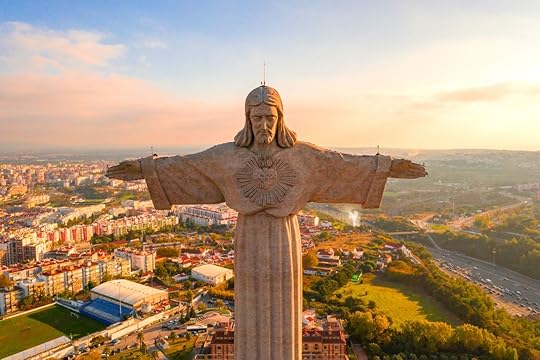
Everyone knows about the iconic Christ the Redeemer statue in Rio de Janeiro, Brazil, but there are actually a number of dramatic statues depicting Jesus Christ around the world. Christ the King in Poland wears a gilded crown. Vietnam’s Christ of Vũng Tàu overlooks the ocean. In Nigeria, Jesus de Greatest is carved from white marble and is the largest statue of Jesus on the continent of Africa. In honor of Easter, we’ve rounded up some of the coolest Jesus statues around the world, be they underwater or on top of a hill.
1. Christ of the Abyss, Florida Keys, US

Photo: Lawrence Cruciana/Shutterstock
Snorkel the warm, clear waters of the vibrant sea garden that is John Pennekamp Coral Reef State Park and you may come across a surprising sight: a large statue of Jesus 25 feet underwater. Christ of the Abyss is located off the coast of Key Largo in the Florida Keys and is one of the most famous dive sites in the world. His hands are raised toward the heavens in a show of peace, and if you can hold your breath long enough, you’ll find a plaque at the base that reads, “If I take the wings of the morning / And swell in the uttermost parts of the sea, / Even there your hand will lead me / and your right hand hold me fast” (Psalm 139:9).
There are two more identical statues elsewhere in the world: The original one is in the Mediterranean Sea near Italy, and there’s another off the coast of Grenada in the Caribbean.
2. Cristo del Otero, Spain

Photo: David Herraez Calzada/Shutterstock
This oddly posed statue of Jesus, located on the outskirts of Palencia in Spain, has a somber, almost morose, expression on his face. Standing nearly 70 feet tall, his posture suggests that he is there to overlook and bless the city below. There is a small chapel and museum at the feet of the statue that contain items by the architect, Victorio Macho, who is also buried there.
3. Lux Mundi, Ohio, US

Photo: ThroughLensPhotosNVideos/Shutterstock
Located at nondenominational Solid Rock Church in Ohio, Lux Mundi (Latin for “light of the world”) was designed by artist Tom Tsuchiya to replace a statue called King of Kings after a lightning strike destroyed it in 2010. The welcoming gesture of the new statue was inspired by the Gospels of Matthew and John in the Bible; in fact, the statue looks so friendly that some have nicknamed it “Hug Me Jesus.” The original statue was a bit more dramatic in posture; Jesus was depicted only from the chest up, with arms outstretched toward heaven and a large cross at the base. Both statues are surrounded by fountains at the church’s baptismal pool.
4. Broken Christ of The Island Shrine, Aguascalientes, Mexico
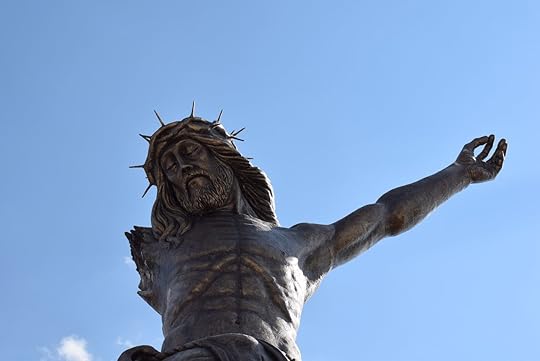
Photo: Jessica Leyva/Shutterstock
Mexico’s Broken Christ of The Island Shrine stands over 80 feet tall in the middle of the Presidente Calles Dam, located in the small town of San José de Gracia. Legend has it that an image of a broken Christ arrived in the town mysteriously. The recipient was going to repair it, but a voice spoke to him in the night and told him to leave it broken as a reminder for his brothers and sisters who also were limited or otherwise oppressed. Visitors can take a ferry or boat ride to the island to see the statue.
5. Jesus Blesses/Christ Blessing, Manado City, Indonesia
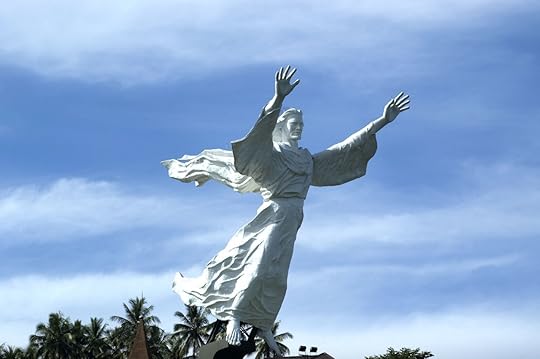
Photo: mosista/Shutterstock
The large, nearly 100-foot statue of “Christ blessing” the people of Manado City, Indonesia, is the world’s fourth tallest statue of Jesus. Constructed of soapstone, the statue is situated on top of a hill and almost appears as if Jesus is flying. It has become a must-see on any trip to Manado City; in fact, the surrounding city is so small that you can supposedly see the statue from anywhere in it, so it serves as a great reference point for visitors.
Unfortunately, because it’s located inside a residential community and therefore surrounded by private homes, you cannot go to the base of the statue, but you can go to an area across from the statue to pose with it in the distance, which some say is a better angle for photos anyway.
6. Christ the Redeemer of the Andes, Chile-Argentina border

Photo: Diego Grandi/Shutterstock
Located high up in the Andes mountain range — over 12,000 feet above sea level — Christ the Redeemer of the Andes straddles the border of Chile and Argentina. It was built in 1904 as a symbol of peace to mark the resolution of the two countries’ border dispute in 1902 after they narrowly avoided going to war. Accordingly, this depiction of Jesus stands on a globe (with South America displayed prominently). His right hand is raised in blessing while his left hand holds a cross.
Hopeful visitors can arrive via dirt road, but the path is precarious with numerous switchbacks and hairpin turns as well as steep cliffs, so the road is not open during the snowy winter months.
7. Christ the King, Portugal
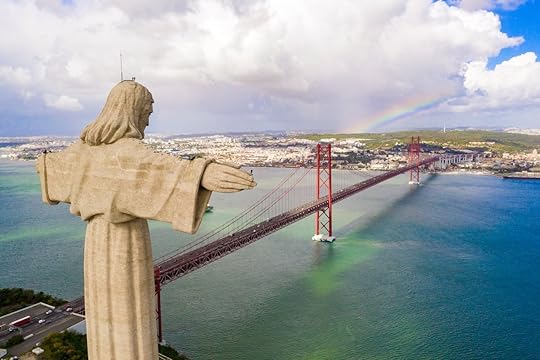
Photo: Ingus Kruklitis/Shutterstock
Inspired by the Christ the Redeemer statue in Rio de Janeiro, Portugal’s Christ the King statue depicts Jesus with arms raised to bless the city; the statue overlooks Lisbon but is located in nearby Almada. It was built in the 1950s as a show of reverence after Portugal managed to avoid the destruction and carnage of World War II. Built on a tall base, the statue offers a viewing platform at the foot of the actual statue of Jesus, and it’s over 250 feet high.
Visitors take an easy ferry ride and bus to get to the monument, which is built among a large complex with gardens, pilgrimage buildings, a chapel, and a café. The grounds, open every day, are free to visit, but the elevator to ascend to the viewing platforms costs a few dollars. 

More like this: 8 beautiful Easter egg traditions around the world
The post The 7 most impressive Jesus statues around the world outside of Rio appeared first on Matador Network.

Israel’s cemetery tombstones digital

Israel just became the first country in the world to have all of its cemeteries completely digitized, thanks to the hard work of MyHeritage, a website that helps users create their family tree online.
Nearly all of Israel’s gravestones are now preserved and searchable online, including free images, locations, and transcribed records. MyHeritage believes that digitizing cemeteries is essential to preserve family history. Gravestones hold vital information, such as a person’s name, dates of birth and death, and names of close relatives, which is highly important for those looking for their roots and to understand their family history. Many gravestones, however, are subject to fading or damaging due to time and weather, rendering them difficult or impossible to read. Because of this, many are simply erased from history and memory.
For the digitization project, MyHeritage teamed up with BillionGraves — an app for iOS and Android. The app allows users to upload photographs of gravestones, which are then transcribed by volunteers on the BillionGraves website, resulting in searchable digital records with GPS coordinates. In Israel, the project has covered 638 different cemeteries throughout the country, with 1.5 million gravestones photographed.
“Even as gravestones continue to wither away,” said MyHeritage, “we can ensure that the footprints of our ancestors do not.” 

More like this: This is the happiest cemetery in the world
The post Israel has digitized all of its tombstones and listed them online appeared first on Matador Network.

Best dispensaries in Seattle

There are plenty of things Seattle is known for. The birth of grunge and Amazon, for example, and as the location for a bunch of scenes in 50 Shades of Grey. Also the unsettling connection to serial killers. Increasingly, however, it’s known for world-class cannabis shops. Whether you’re just passing through or you’re looking to make Seattle your home, Seattle is a city where cannabis lovers can be forever satisfied.
These are the best recreational cannabis dispensaries in Seattle.
1. Have a Heart

Photo: Have a Heart/Facebook
While Have a Heart has multiple locations in Seattle and even more in other states, the Belltown spot wins out in convenience — especially for people just visiting the city. It’s a short distance away from both the Space Needle and Pike Place Market, and it has an incredibly large selection. The staff is cognizant of how its location may attract first-timers who may not know the ins and outs of visiting a recreational dispensary for the first time and can help you navigate the menu. With solid prices, it’s also not a bad place to be a regular.
Locations: 115 Blanchard St (Belltown location), 12833 Martin Luther King Jr Way S, and 300 NW 85th St
2. Uncle Ike’s
Three words: deals, deals, deals. The three Uncle Ike’s shops in Seattle have the best prices in town. When you just want to get in and get out without leaving your wallet as a deposit, Uncle Ike’s is the place to be. It does have a bit of a reputation thanks to owner Ian Eisenberg, however. Eisenberg made a name for himself by blocking out competitors and confronting protestors on the street. That shouldn’t impact the opinion of deal seekers, though.
Locations: 2310 E Union St, 501 15th Ave E, and 9822 15th Ave SW
3. Diego Pellicer

Photo: Diego Pellicer Washington/Facebook
If you’ve visited some shops in Denver or know a thing or two about high-class dispensaries, there’s a good chance you recognize the name Diego Pellicer. The luxury dispensary has an outpost in Denver as well, and both made our list of the best recreational dispensaries in the US. And by luxury, we mean luxury. Inside looks like ancient Greek meets 21st-century dispensary with a little bit of Vegas flair. The attention to detail extends to the staff and the products as well, with high-quality and affordable cannabis. If you’re still having trouble in this day and age with convincing someone in your group that cannabis has moved beyond its seedy past, this is where to go.
Location: 2215 4th Ave S
4. Kush21
If Have a Heart wins out in foot traffic convenience, Kush21 wins out in just-got-to-Seattle-where’s-the-weed convenience. It’s a short distance from the airport and hits all the right notes when it comes to quick-purchase price points. The staff is friendly, and it’s a place where you’re just as welcome to chat as get in and get out.
Location: 17730 Ambaum Blvd South D
5. Dockside Cannabis

Photo: Dockside Cannabis Museum/Facebook
Say you’ve got some time to dawdle away and want to learn a little more about marijuana. If that’s the case, linger for a bit at Dockside, where there’s an exhibit of cannabis artifacts that aren’t exactly ancient, but they’re definitely not from this century. Reputable people are on staff who make the media rounds as experts explaining the ins and outs of flower, concentrates, and edibles. The prices can be a little higher here than others on this list, but you’ve got to factor in the service and selection somehow.
Location: 1728 4th Ave S
6. Lux Pot Shop
The modernist shop to Diego Pellicer’s Greek revivalism. A visit to Lux Pot Shop is a bit like walking into a future where nothing is dirty and everything is bright, well-lit, and organized just so. It used to be called Stash but ditched the name in 2017 and now has two locations in the city with the decidedly more upscale name of Lux. Both stores have anything you could ask for — including cannabis teas and apple drinks — and a staff that can help even the most indecisive person decide.
Locations: 4912 17th Ave NW and 10333 Lake City Way NE
7. Pot Stop

Photo: Pot Stop/Facebook
Come to Pot Stop for the selection, stay for the people. The shop covers the basics and then some, and the budtenders will help you nail down exactly what you’re looking for, even if you’re not really sure what you’re looking for. Having opened in 2011, it’s the oldest marijuana shop in Seattle, and that trust it’s built with customers — whether they’re the type the buy only the cheapest deals or the type that goes for the finer stuff — says a lot about the experience you’ll have when you visit.
Location: 4465 Fremont Ave N 

More like this: How Seattle’s suburban Eastside became a jumping off point for all that’s great about Washington
The post The 7 best recreational cannabis dispensaries in Seattle appeared first on Matador Network.

Racing pigeon auctioned for $1.4 mil

It’s not only horses who can tear it up at the racetrack and be sold for millions. This star racing pigeon named Armando from Belgium sold for $1.4 million in an auction over the weekend, and according to PIPA, the group organizing the sale, he might be “the best long distance pigeon of all time.”

Photo: PIPA
As a racer with an impressive prize list, there was no question that Armando would fetch a sizeable sum at auction, but nobody was expecting such numbers.
After fierce bidding war, a buyer from China forked over $1.4 million and took Armando home. PIPA noted that the result wasn’t exactly a surprise; in 2017, Joël Verschoot, Armando’s seller, had already broken a record by selling a pigeon named Nadine to Xing Wei, a Chinese property tycoon, for almost $455,000, according to The Guardian.
The pigeon industry is more competitive than many may think. PIPA said the auction “marked the start of an exciting two-week bidding race that involved many international names,” and that the $1.4 million bid makes Armando the most expensive bird ever to be sold in auction. Joël Verschoot, his seller, also sold 178 other pigeons in the auction, for a total of about $2.7 million.
Although pigeons are often dismissed as “dirty birds” because of their ubiquitous presence in cities around the world, they are incredibly fast flyers with a sense of direction humans can only dream of, hence the popularity of pigeon racing in China. Pigeons, besides being amazing racers, were also used during WWII as spies for the resistance against nazis. Pretty good for what some call “sky rats.” 
H/T: Insider

More like this: Millennials are super into birding now. Here are the best places to go birding around the world
The post Racing pigeon Amando sells for $1.4 million at auction appeared first on Matador Network.

Albania uses movie “Taken”

Albania’s newest tourism campaign is tackling the country’s negative stigma head-on. Taken, a 2008 movie starring Liam Neeson, has given the world the impression that Albania is a haven for organized crime and kidnappers, and the country’s tourism bureau wants to put an end to it — in a hilarious way.
In the movie, Liam Neeson’s daughter is kidnapped by Albanian human traffickers and sold into the sex trade. The “Taken By Albania” tourism initiative is all about promoting the country’s gorgeous beaches, nature, castles, culture, friendly locals and more by embracing the popularity of the movie and putting a positive spin to it.
Actor Arben Bajraktaraj, aka “Marko from Tropoja” in the movie, even makes an appearance in the promotional video to debunk some stereotypes and invites travelers, including Neeson, to see a side of the country that was definitely not shown in the film. There is also a petition on the campaign website to get Neeson to visit and “be taken” by the country’s beauty.
Whether or not the campaign successfully reassures people about traveling to Albania and attracts tourists remains to be seen, but one thing is for sure: Albanians have a great sense of humor. 
H/T: Lonely Planet

More like this: Albania hides the world’s best undiscovered beaches
The post Albania’s bizarre new tourism campaign is all about Liam Neeson’s ‘Taken’ appeared first on Matador Network.

March 19, 2019
Things to see and do in Kolkata

If there is a city in India where traditional heritage merges with the contemporary, the city of Kolkata is it. Nostalgia seeps from every alley and suffuses the classic old trams, the yellow taxis, and the iconic Howrah Bridge. Even the bars of Park Street have a classic West Bengali air to them. In this city that saw the dawn of the Indian cultural renaissance a century ago, modern artists, writers, filmmakers, and performers still use Kolkata to hone their crafts and launch their careers. At the same time, India’s third largest metropolis and the capital of West Bengal is also a city of contrasts — between glistening new malls and wrenching poverty. Here is why Kolkata — with its symphony of colors and sounds, mashup of history and modernity, and blend of India’s many religions and cultures — offers the ultimate view into West Bengal society.
The oldest road in Kolkata dates back centuries.

Photo: Radiokafka/Shutterstock
Centered on the east bank of the Hooghly River, an arm of the holy Ganges, Kolkata’s name is thought to derive from the Bengali Kolikata. Kolikata was one of the three villages that predated the arrival of the British and is often translated as “the field of goddess Kali.” The presence of the goddess is felt all over the city, but it’s in the southern Kalighat Kali temple that thousands of devotees pray every day. Kolkata’s oldest path, Chitpur Road, leads the way to the famous temple, and you can still walk along it to see how some of its streets are still centered around specific trades or crafts — from wood carving to candy making.
Throughout the Age of Exploration from the 15th to 17th century, India was subjected to European colonial rule. The British Raj, when Great Britain ruled the entire Indian subcontinent, lasted from 1858 to 1947 — but the British East India Company had arrived 250 years earlier in 1612. In 1772, the East India Company made Kolkata, which they called Calcutta, the capital of British India, and it remained the capital until 1911.
Reminders of India’s colonial past abound.

Photo: Manab Das/Shutterstock
Although India gained independence on August 15, 1947, Kolkata’s buildings are a constant reminder of the country’s colonial past. The white-marbled Victoria Memorial is the most grandiose example. Built in commemoration of Queen Victoria, it holds a visual display of the colonial-era history and is surrounded by a collection of large and serene gardens. A walk through the city could also lead you to the nearby St. Paul’s Cathedral, the Central Post Office, or the Writers’ Building, each a chapter in Kolkata’s storied history.
If contemporary history interests you most, prepare to find hammer-and-sickle motifs drawn into walls all around the city. Kolkata is still the capital of the state of West Bengal, and from 1977 to 2011, West Bengal was the home of the world’s longest-serving, democratically elected communist government. You can find a reminder of this time near the Esplanade bus station where a statue of Lenin still surprises unexpecting pedestrians. Also, Kolkata was the first Indian city to get a metro line, which was designed by Soviet specialists back in 1971.
Kolkata was the birthplace of India’s modern cultural renaissance.

Photo: Zvonimir Atletic/Shutterstock
The then-capital was the birthplace of the cultural renaissance that in the mid-19th century spread throughout India. The main exponent of it was Rabindranath Tagore, who in 1913 became the first non-European to receive the Nobel Prize for Literature. To get to know his thoughts, pay a visit to the museum at Jorasanko Thakurbari Bari or make the trip out to Shantiniketan, a town in rural West Bengal where he founded an experimental school.
To grasp a sense of the city’s strong cultural beat, take the tram to College Street, considered the largest second-hand book market in the world. It’s said that if you can’t find a book here, it probably never existed. A few steps away from the Presidency University you will run into the Indian Coffee House, also called the College Street Coffee House, a longtime meeting point for the city’s scholars, artists, and writers. Legendary film directors Satyajit Ray and Mrinal Sen were some of those who spend long hours of discussions there. Today it’s still a hangout for college students who very well may become India’s next great thinkers and creators.
West Bengal is a land of festivals, and Kolkata is a city of religions.

Photo: Rudra Narayan Mitra/Shutterstock
They say that in West Bengal there are 13 festivals in 12 months. Even though all religions are celebrated with equal enthusiasm and passion, Kolkata transforms into the most colorful and chaotic city during the Hindu festival of Durga Puja. For five days in September or October, locals celebrate the victory of good over evil and pay their respects to idols of the 10-armed goddess Durga, which are displayed in a series of beautifully decorated scenarios. If you want to see how the statues are created, walk around the traditional potters’ area of Kumortuli. Once the festival comes to an end, make your way down to the Hooghly River where the Durga idols are thrown into the sacred waters.
Wandering the streets of Kolkata is a reminder that, no matter the time of year, this is a city of religions. The Magen David Synagogue, the Armenian Church, and the Nakhoda Mosque are just minutes away from each other in the Barabazar area. To get the full experience of this side of the city, you can’t miss Mother Theresa’s Missionaries of Charity or Belur Math, the headquarters of the Ramakrishna Math and Mission.
The historical sites shine, but the heart of Kolkata lies in its cuisine.

Photo: alexreynolds/Shutterstock
A common phrase to describe someone of Bengail descent is mache bhate Bangali, which translates to “fish and rice is what makes a Bengali.” It’s no surprise then that traditional Indian eats can be found throughout the city. Rather than being served all at once, Bengalis prefer the multi-course tradition. Bitter preparations, leafy vegetables, lentils, a non-vegetarian curry, and chutney are displayed one by one before reaching a last sweet treat like the traditional Sandesh or rosogolla.
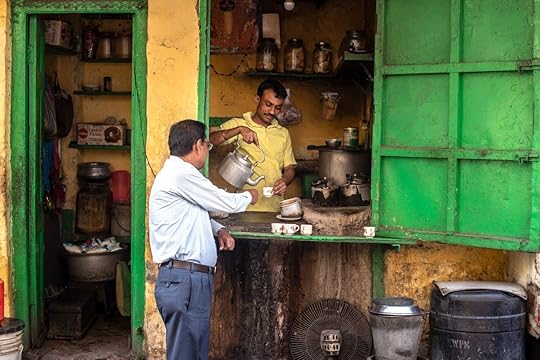
Photo: Yavuz Sariyildiz/Shutterstock
When walking around Kolkata, you should also keep an eye open for street vendors who have a good line of ravenous diners waiting to purchase their preparations. Put your plans on hold and wait in that line. You’ll thank yourself once you get to the front as the city has built a reputation as one of the best destinations for street food in India. Phuchka is the city’s favorite dish, but there are plenty of Tibetan momos, egg rolls, and potato-filled singara for those who prefer less spicy options. And whatever you do, don’t leave the city without trying a steaming clay cup of masala chai from a street vendor. 

More like this: The most beautiful temples in India you’ve never heard of
The post Why Kolkata offers the ultimate blend of classic and contemporary culture in India appeared first on Matador Network.

Best dog sledding in Park City, Utah

Cradling an 80-pound Alaskan husky like a baby, an impassioned Fernando Ramirez traces his intense bond with his dogs back to his childhood. When he was an eight-year-old in Park City, Utah, he desperately wanted to take up dog sledding. His mother, who grew up on a farm in Mexico breaking horses and taking in stray dogs, agreed under one condition: He must use rescue dogs. Twenty years later, when Fernando decided to step away from pursuing a career in physical therapy and marathon racing to follow his passion for dog sledding, he turned to his old pals: the rescues.
From huskies to wolf mixes

Photo: Laurie Larsh
Zoe, Nutella, Skunk, Fox, Cheppy, Nickel, and Sox are just some of the 54 dogs that currently reside at Ranchos Luna Lobos in Park City, Utah, a family-owned and operated dog-sledding company. Spanning breeds from huskies, greyhounds, and shorthair pointers to malamutes and wolf mixes, all have a trace of a northern breed. Some rescues, like Arctic, a three-time Iditarod winner, arrive to the ranch healthy and ready to be part of the team. Others are mere skin and bones, victims of malnourishment and mistreatment. Regardless of their state, the moment a dog is brought onto the Luna Lobos property, it is treated as part of the family.
In a sport where purebred bloodlines are carefully cultivated and breeding reigns supreme, the Luna Lobos team is a bit of a Bad News Bears crew. The hodgepodge of breeds means varying degrees of stamina, endurance, and recovery capabilities. Add to that managing the individual personalities and quirks of each dog, and putting together a race team becomes a lot like assembling a jigsaw puzzle. Fernando thrives on this challenge and spends his days trying to understand and bond with each dog individually. His hard work paid off. At the 2019 Pedigree Stage Stop Challenge in Wyoming, he was able to cobble together a team that placed an impressive 17th out of 26 of the most elite mushers in the world.
Taking in all dogs, whether they can sled or not

Photo: Laurie Larsh
Fernando and his wife Dana have taken in more than 120 dogs since opening in 2010. Their first priority is not getting the dogs trained to be sled dogs but rather ensuring that each dog is in a healthy, functioning state. “Not every dog that comes to us is destined for the Iditarod, and that’s okay,” said Fernando. “First and foremost we want them to be healthy, happy, and well-adjusted, and if that means in the end they are simply ready to be loved by a family, then we are here to help them get there.”
Take Gypsy, for example, a purebred Siberian Husky who was three body widths overweight and barely able to walk around the ranch when she arrived. It took many months of a strict diet and gradual increases in exercise get her back to a healthy weight. But despite her Siberian Husky roots and new, svelte figure, Gypsy quickly made her disinterest in running known. When she was hooked up to the line she would promptly take a seat, flat out refusing to run and stopping the sledding team in their tracks. Fortunately, the Ramirez family was able to find Gypsy the career, and human companion, of her dreams. She now lives an exciting life posing for pictures alongside her model owner.
Overcoming canine disabilities

Photo: Laurie Larsh
On the flip side, there are unexpected naturals like Humberto. Humberto came to Luna Lobos painfully skittish, clumsily tripping over anything in his path. The mystery behind his unwieldy ways was quickly solved by the family vet who confirmed that Humberto was born 100 percent blind in both eyes. It took an entire winter season before Humberto began to feel safe enough to allow himself to be teamed up with a buddy and led around the play yard. Eventually, this progressed to being buddied up on the line for tours. Just one year later, Humberto showed such love and skill for racing he became a lead dog.
Humberto and his sledding buddies work hard at what they do. In the winter, the conditioning process involves giving dog-sledding tours to guests, covering about 10 miles each day. A more select group of dogs comprise the racing team and train 30-35 miles per day in preparation for major races like the Pedigree Stage Stop Challenge. In the summer, the furry athletes, as Ramirez refers to them, give land “safari” tours and swim at the local reservoir to stay in shape. They also get in plenty of free time playing with the four Ramirez children, as well as those who attend the various camps and junior dog-sledding activities that run throughout the year.
A lot of effort — and worth every minute of it

Photo: Laurie Larsh
In order to get sled dogs that are in racing condition, many of the top mushers will purchase or lease dogs from breeders. These dogs come from proven purebred bloodlines that are naturally athletic, work well in a pack, and are built for Arctic racing conditions with ample fur and durable feet. Price tags for these dogs start at hundreds of dollars and can exceed $20,000 for a season-long team lease. By using rescues for their sled team the Ramirez family is not only taking on the challenge of endurance and team training but also rehabbing the rescues and coaching them individually to become sled dogs. They are willing to do the extra work because they believe there is no price tag that can be put on saving the life of a dog.
The Ramirez family’s passion for their canine kin is evident from the moment they greet you at Luna Lobos. Visitors travel along a path that was hand dug by Fernando and Dana — a three-year labor of love — towards a symphony of barking and frantically waving tails. In addition to being introduced to the dogs individually, guests are able to learn about what it takes to care for them, including the intense 16-hour days, monthly visits from the vet, and 6,000 pounds of food that only lasts six weeks.
Dog sledding conjures up visions of gliding over snow-covered hills, looking out over the seemingly untouched mountain range, feeling the rush of crisp mountain air — and Luna Lobos delivers. What is unexpected is the emotional experience of witnessing firsthand the power of the bond between man and dog. “I see my dogs as an extension of me and they can feel that,” Fernando shared. “There have been times out on the trail where we’ve lost our sleds and certain dogs just know and they stop and look back as if to say, ‘“No one gets left behind on our team.’” It’s almost as if even the dogs know the family mantra. 

More like this: This tour company offers epic vacations for you and your doggy
The post This Utah family has saved over 100 rescue dogs through dog sledding appeared first on Matador Network.

Cleanest airlines in the world

Skytrax, a UK-based aviation industry reviewer, asked passengers to rate the standard and quality of aircraft cabins, and the results are in. Based on the results of Skytrax’s global survey, the world’s cleanest airlines have been revealed, and the list is overwhelmingly lopsided. Not a single US– or UK-based carrier made the list. Instead, it was dominated largely by airlines from Asia. Japan’s All Nippon Airways claimed the list’s number one spot, with Singapore Airlines, Japan Airlines, Cathay Pacific Airways, Qatar Airways, Swiss International Airlines, and Lufthansa also cracking the top 10.
Note that this study wasn’t based on any actual science or swabbing but instead on passenger opinions. Passengers considered the cleanliness of seat areas, tables, carpets, cabin panels, and bathrooms while providing input for the rankings.
Here is the full list of the top 30:
1. ANA All Nippon Airways
2. EVA Air
3. Asiana Airlines
4. Singapore Airlines
5. Japan Airlines
6. Cathay Pacific Airways
7. Qatar Airways
8. Swiss International Air Lines
9. Hainan Airlines
10. Lufthansa
11. Korean Air
12. Cathay Dragon
13. Austrian Airlines
14. China Airlines
15. Thai Airways
16. Garuda Indonesia
17. China Southern Airlines
18. Bangkok Airways
19. Emirates
20. Air New Zealand
21. Etihad Airways
22. Qantas Airways
23. Hong Kong Airlines
24. KLM Royal Dutch Airlines
25. Finnair
26. Oman Air
27. Virgin Australia
28. Air France
29. Turkish Airlines
30. Philippine Airlines
Since not a single British or American airline made the top 30, it should serve as a significant motivation for those airlines to improve their standards of cleanliness. 
H/T: Secret Flying

More like this: The world’s safest airlines of 2019
The post The top 30 cleanest airlines were just revealed, and none from the US or UK made the list appeared first on Matador Network.

Mexico's Popocatépetl volcano erupts

After the Popocatépetl volcano erupted late Monday in central Mexico, residents are being warned about ash rain and mudslides. According to Mexico’s National Centre of Disaster Prevention (CENAPRED), the eruption spewed a column of ash nearly 4,000 feet into the air, and while there haven’t been any reported injuries yet, CENAPRED is encouraging people to be watchful.
Following the blast, smaller explosions are liable to follow, as well as ash rain and mudflows in nearby communities. In a statement, CENAPRED asked the public “not to approach the volcano and especially the crater, because of the danger involved in the fall of ballistic fragments.” In addition to the agency’s warning, the Mexican government has issued a “yellow phase two” volcano alert and set up a 7.5-mile exclusion zone around the summit to make sure people stay at a safe distance.
Prior to the 1990s, the 17,797-foot volcano — whose name literally means “smoking mountain” — had been dormant for over 50 years. Since then it has been the site of sporadic activity, including several significant eruptions each year. Twenty-three million people live within 60 miles of the volcano’s crater — Mexico City is just 43 miles away — all of whom will be on high alert over the next few days. 
H/T: The Independent

More like this: 6 active volcanoes you can actually go and see up close
The post Popocatépetl volcano, just 43 miles from Mexico City, has erupted appeared first on Matador Network.

Matador Network's Blog
- Matador Network's profile
- 6 followers



